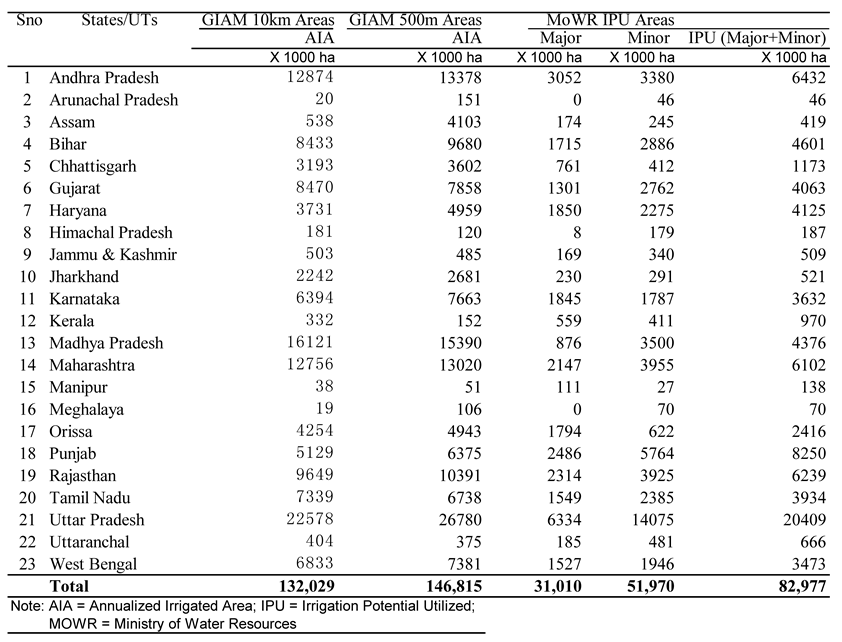Irrigated Area Maps and Statistics of India Using Remote Sensing and National Statistics
Abstract
:1. Introduction
2. Methods
2.1. Definitions
2.1.1. Total area available for irrigation (TAAI)
2.1.2. Annualized irrigated areas (AIAs)
2.2. Data used and resolutions
2.3. Methods for mapping irrigated areas using remote sensing
3. Results and Discussions
3.1. TAAI (GIAM) and its comparison with NIA (DES)
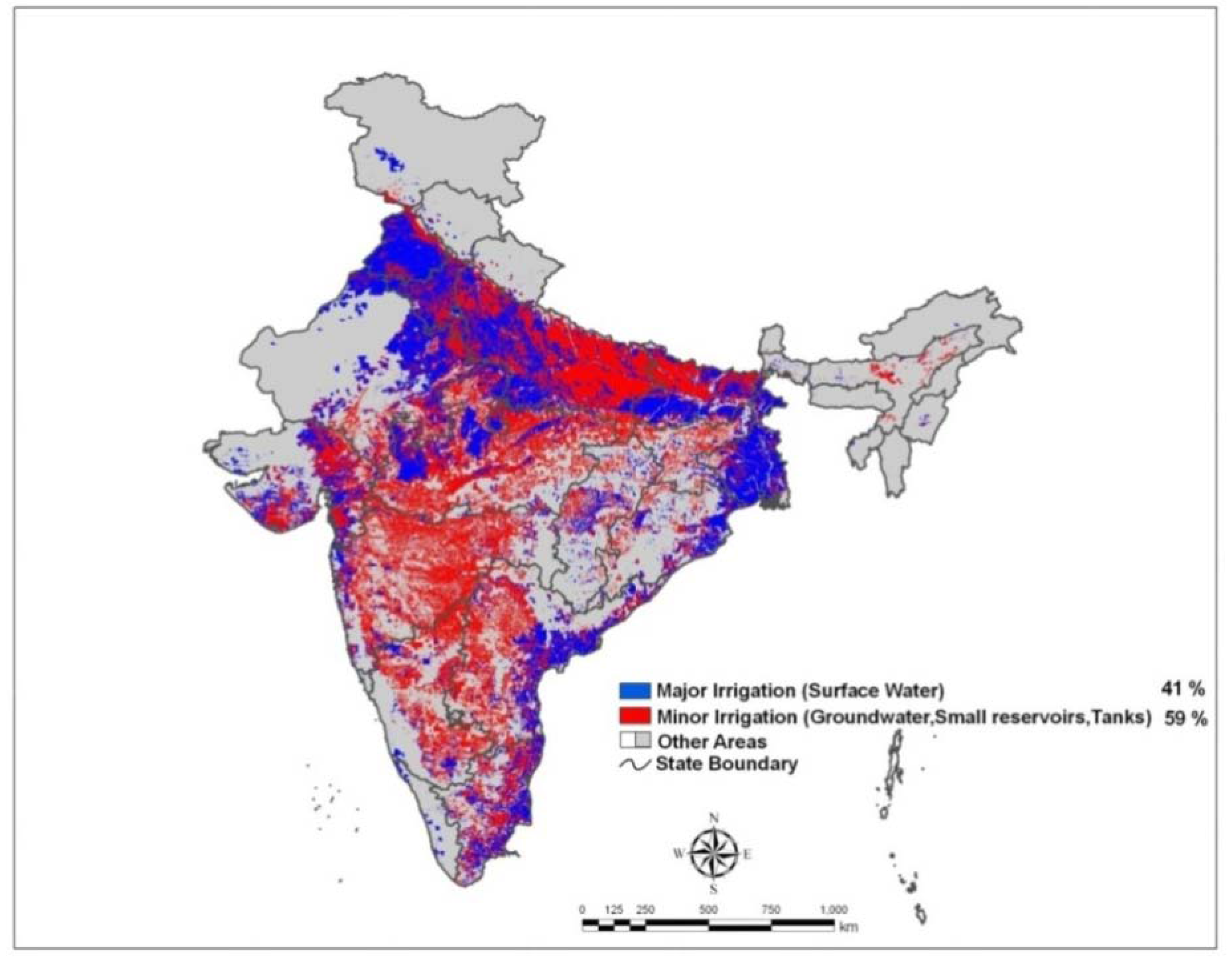
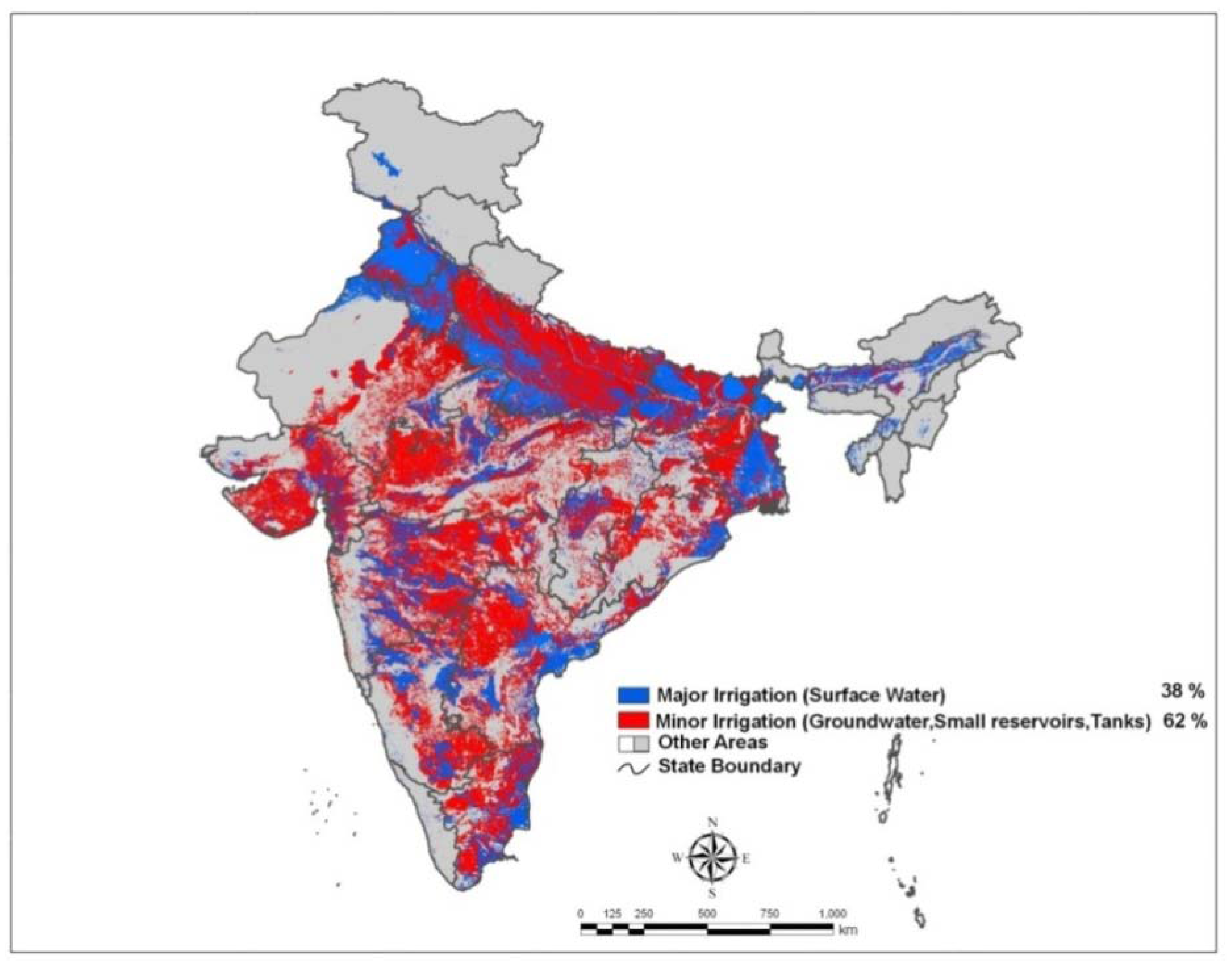
3.2. GIAM AIA and its comparison with MoWR IPU
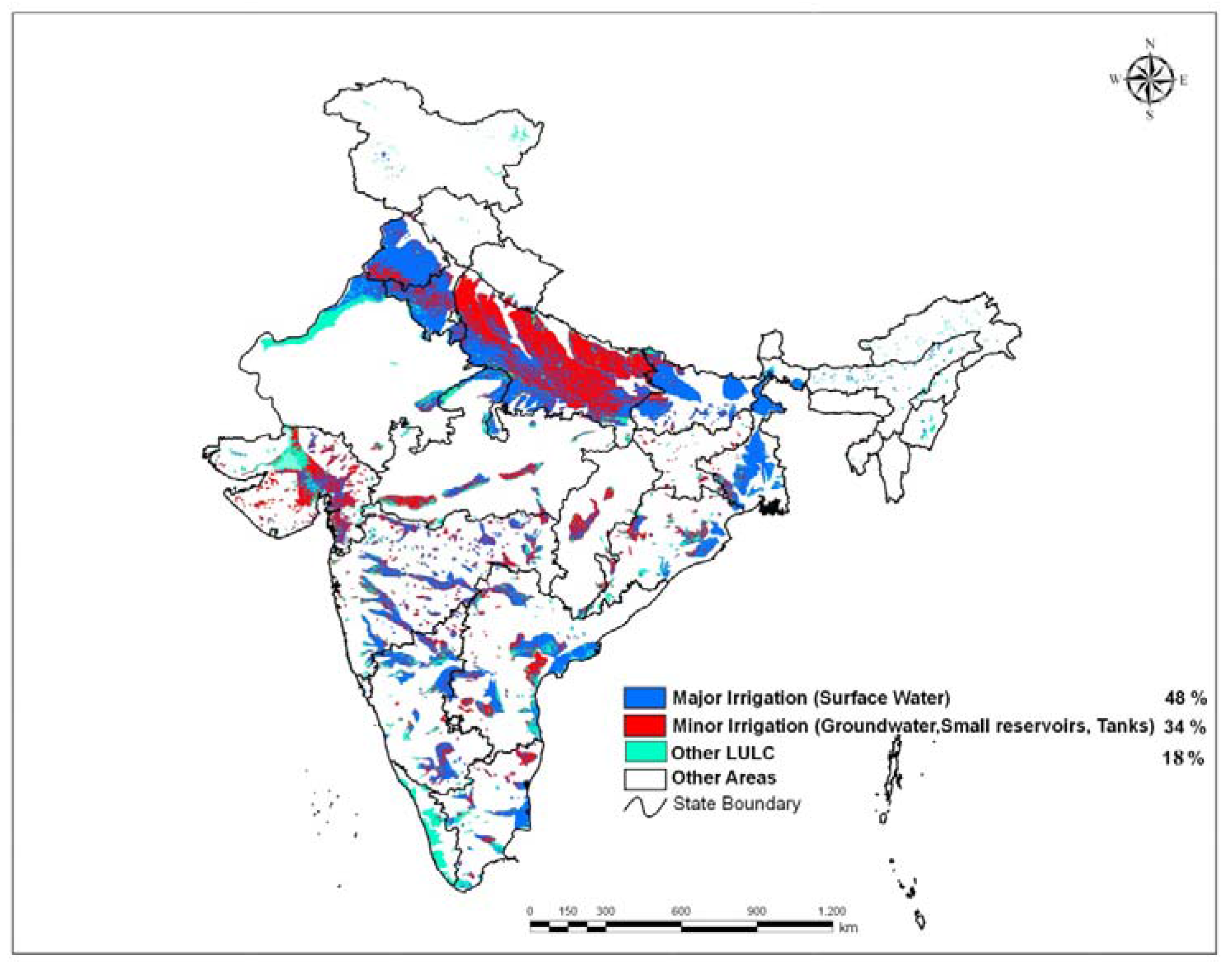
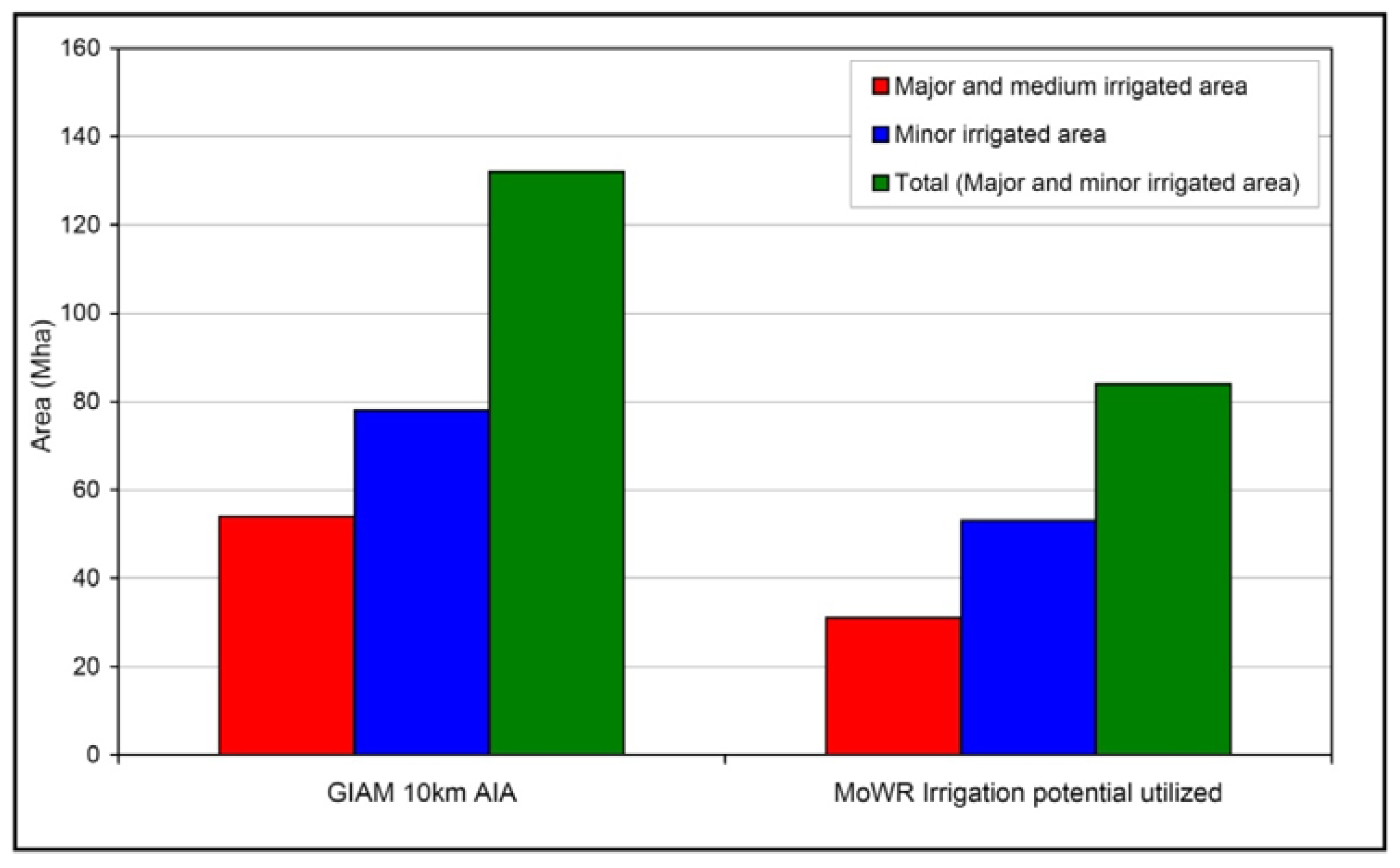
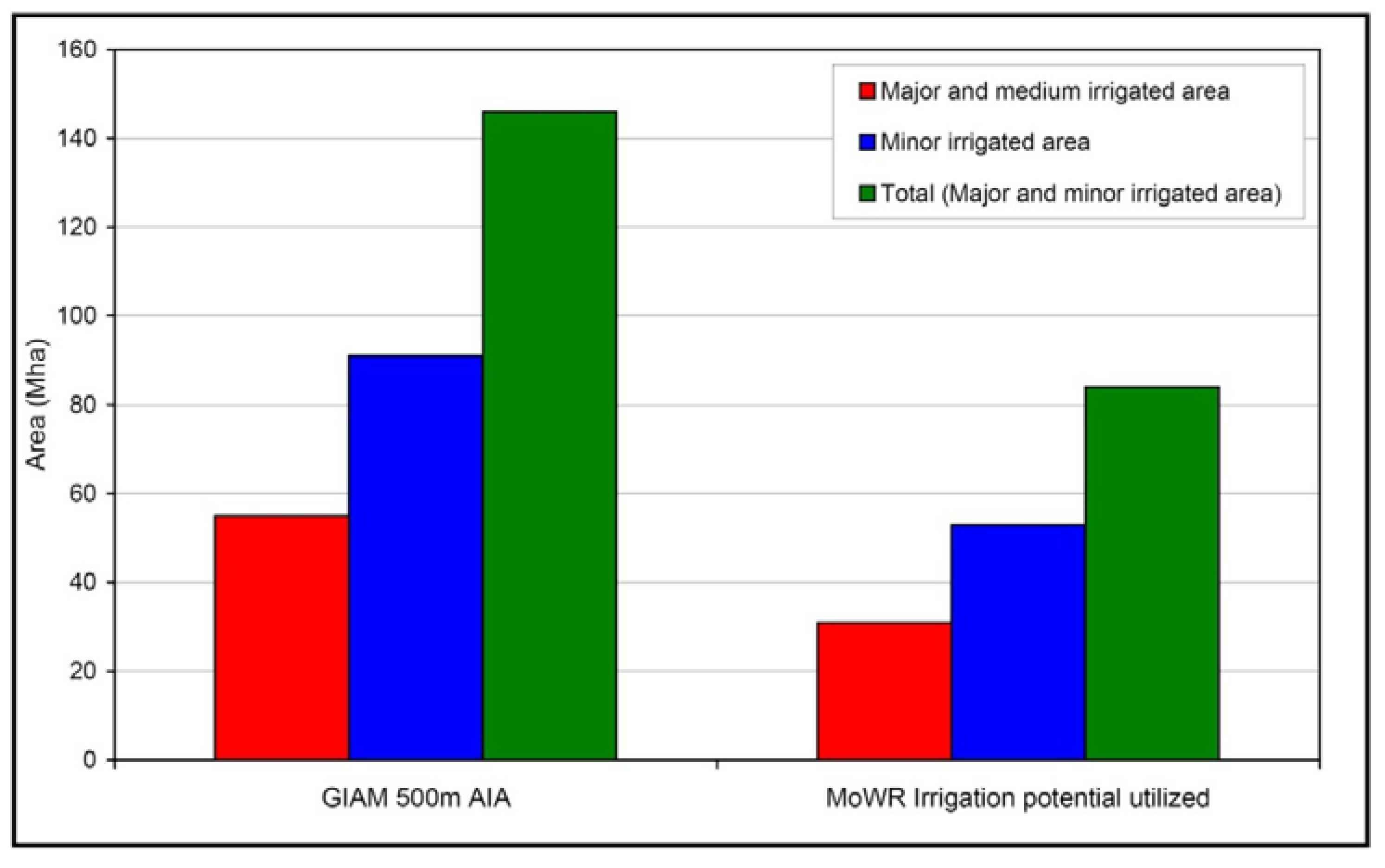
3.3. Comparison of state-wise GIAM irrigated areas with the MoWR and DES census
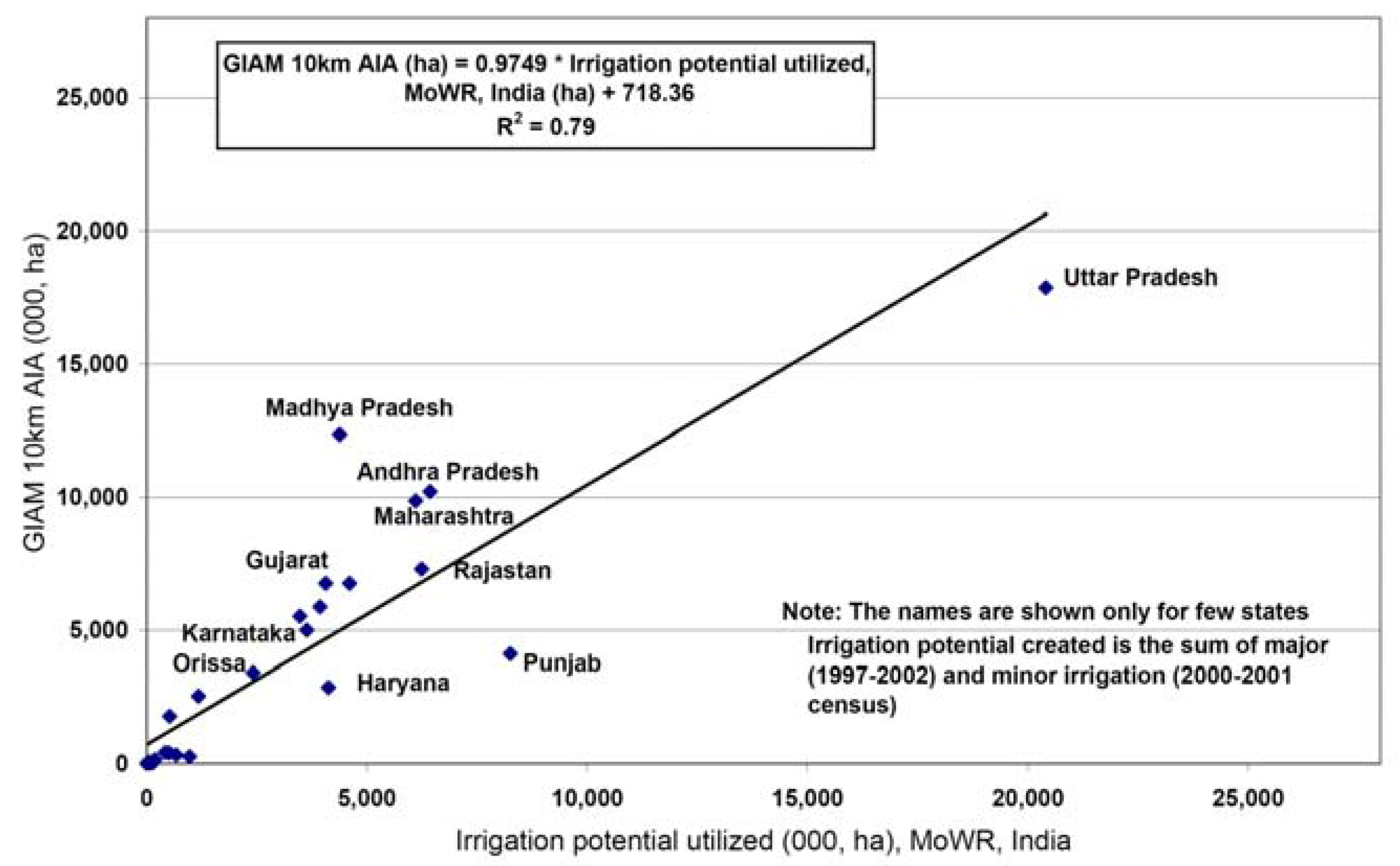
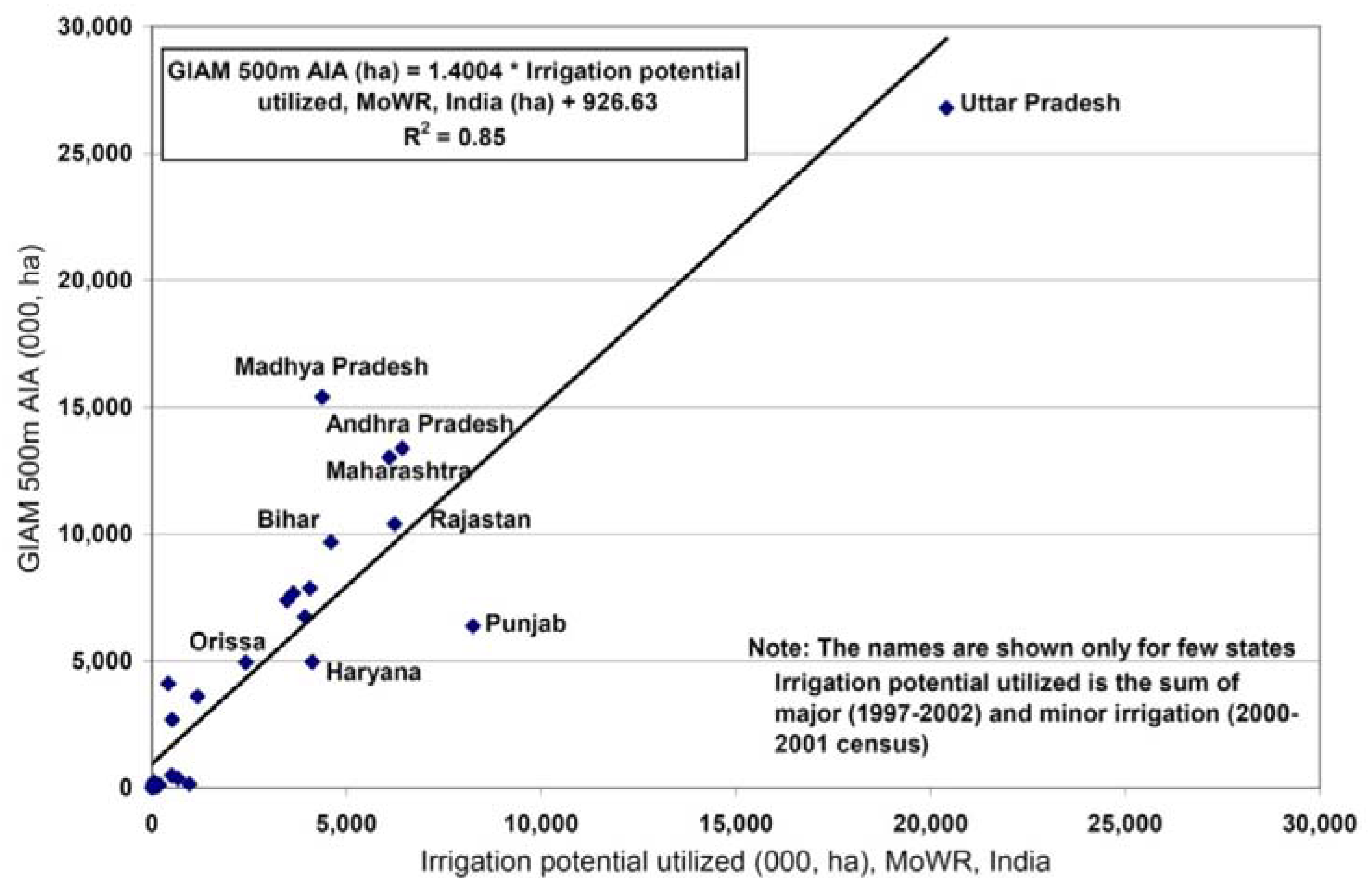
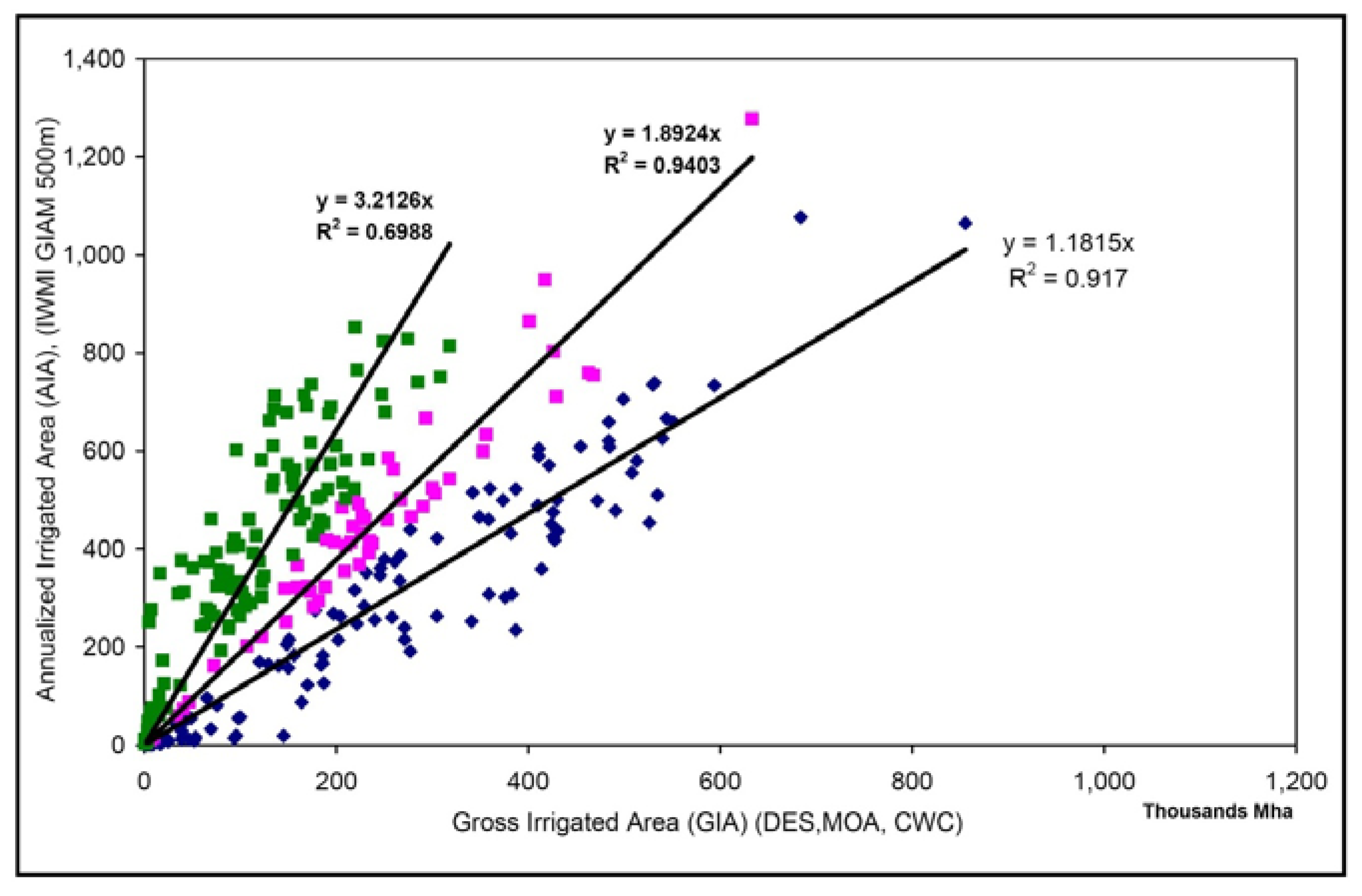
3.4. Causes of differences in irrigated areas between GIAM and Indian national statistics
3.4.1 Inadequate accounting of irrigated areas in the National Statistics
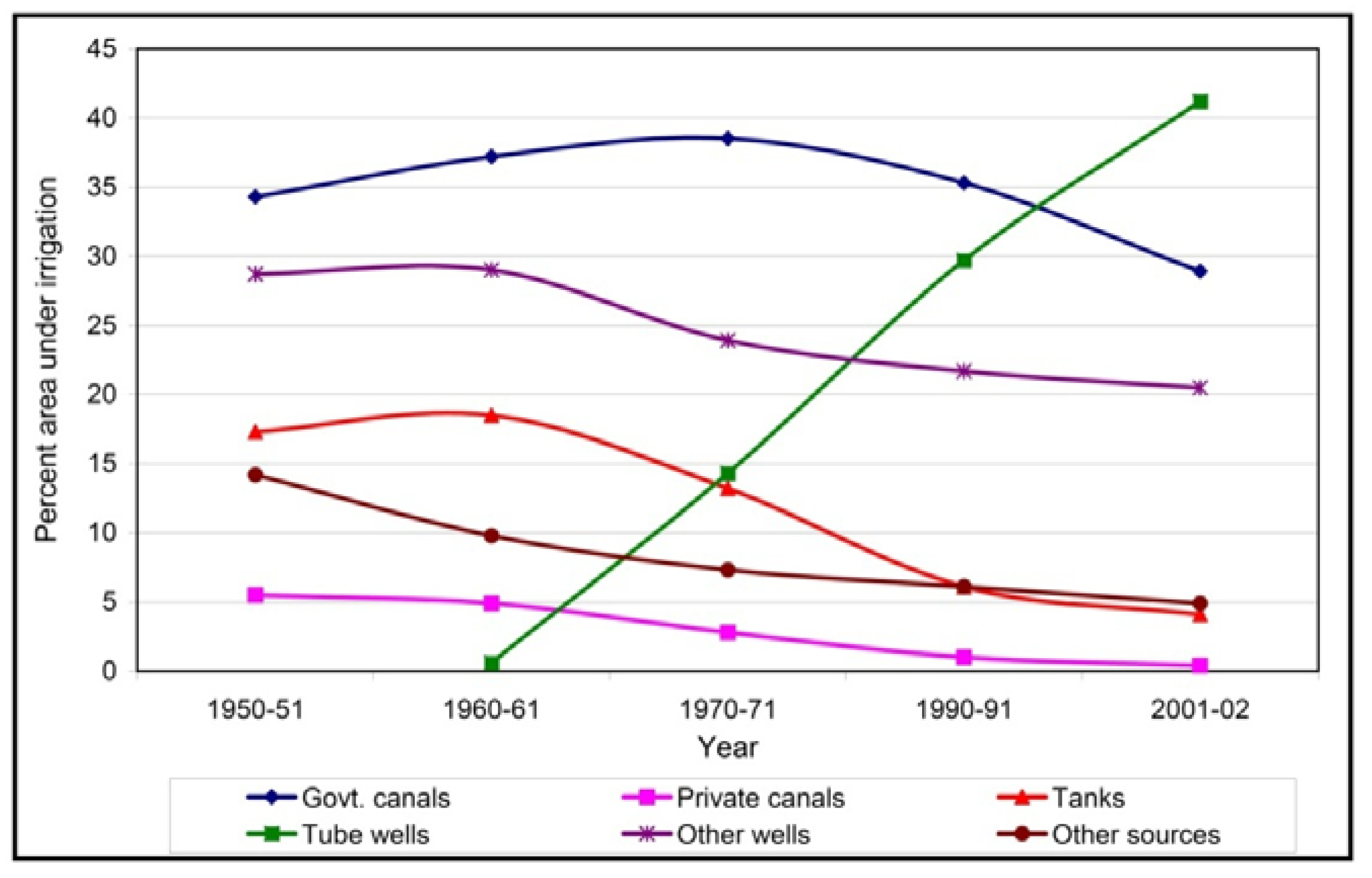
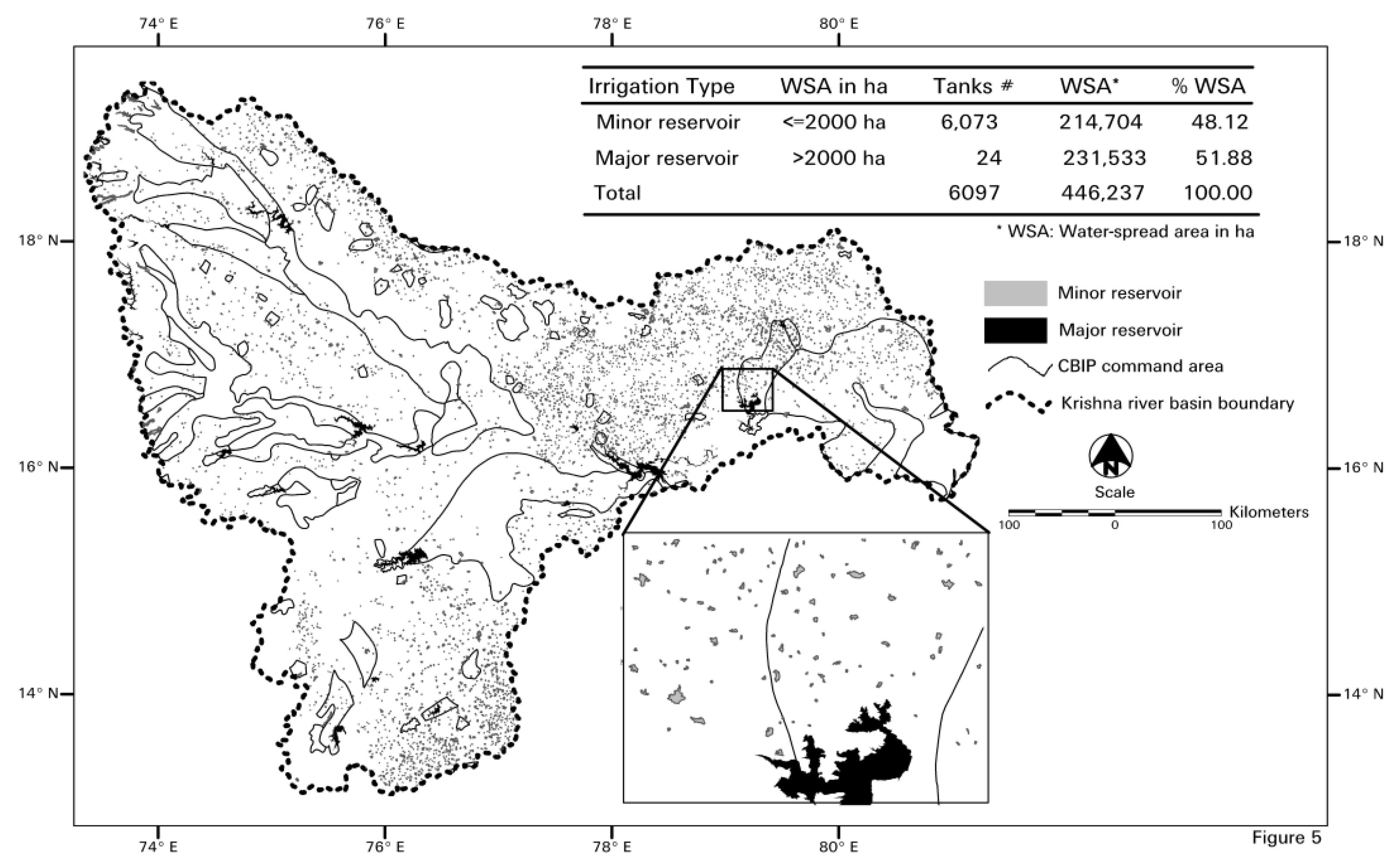
3.4.2. Resolution of the imagery
3.4.3. Definition issues

3.4.4. Irrigated area factions (IAFs)
3.4.5. Improper computation of areas
4. Conclusions
Acknowledgements
References and Notes
- Thenkabail, P.S.; Biradar, C.M.; Noojipady, P.; Dheeravath, V.; Li, Y.J.; Velpuri, M.; Reddy, G.P.O.; Cai, X.L.; Krishna, M.G. A Global Irrigated Area Map (GIAM) Using Remote Sensing at the End of the Last Millennium. Int. J. Remote Sens. 2009, (in press). [Google Scholar]
- Siebert, S.; Hoogeveen, J.; Frenken, K. Irrigation in Africa, Europe and Latin America - Update of the digital global map of irrigation areas to version 4. In Frankfurt Hydrology Paper 05; Institute of Physical Geography, University of Frankfurt, Frankfurt am Main, Germany and Food and Agriculture Organization of the United Nations: Rome, Italy, 2006. [Google Scholar]
- Siebert, S.; Döll, P.; Hoogeveen, J.; Faurès, J-M.; Frenken, K.; Feick, S. Development and validation of the global map of irrigation areas. Hydrol. Earth Syst. Sci. 2005, 9, 535–547. [Google Scholar] [CrossRef]
- IWMI. Available online: http://www.iwmigiam.org (accessed on December 12, 2008).
- FAO. Available online: http://www.fao.org/AG/agL/aglw /aquastat/main/index.stm (accessed on December 15, 2008).
- Dheeravath, V.; Thenkabail, P.S.; Chandrakantha, G.; Noojipady, P.; Biradar, C.M.; Turral, H.; Reddy, G.P.O.; Velpuri, M. Irrigated Areas of India derived using MODIS 500 m data for years the 2001-2003. ISPRS J. Photogram. Remote Sens. 2009. (submitted). [Google Scholar]
- Endersbee, L. A voyage of discovery: A history of ideas about the earth, with a new understanding of the global resources of water and petroleum, and the problems of climate change. Monash University Bookshop: Frankston, Victoria, Australia, 2005. [Google Scholar]
- MoWR (Ministry of Water Resources). 3rd Census of Minor Irrigation Schemes (2000-01); Ministry of Water Resources: New Delhi, India, 2005.
- Thenkabail, P.S.; Biradar, C.M.; Turral, H.; Noojipady, P.; Li, Y.J.; Vithanage, J.; Dheeravath, V.; Velpuri, M.; Schull, M.; Cai, X. L.; Dutta, R. An Irrigated Area Map of the World (1999) derived from Remote Sensing. Research Report # 105; International Water Management Institute: Colombo, Lanka, 2006; p. 74. Available online: http://www.iwmigiam.org.
- Biradar, C.M.; Thenkabail, P.S.; Noojipady, P.; Yuanjie, L.; Dheeravath, V.; Velpuri, M.; Turral, H.; Gumma, M.K.; Reddy, O.G.P.; Xueliang, L.C.; Schull, M.A.; Alankara, R.D.; Gunasinghe, S.; Mohideen, S.; Xiao, X. A global map of rainfed cropland areas (GMRCA) at the end of last millennium using remote sensing. Int. J. Appl. Earth Obs. Geoinf. 2009, 11, 114–129. [Google Scholar] [CrossRef]
- Velpuri, M.; Thenkabail, P.S.; Gumma, M.; Biradar, C.M.; Dheeravath, V.; Noojipady, P.; Yuanjie, L. Influence of Resolution or Scale in Irrigated Area Mapping and Area Estimations. Photogram. Eng. Remote Sens. 2007. (accepted). [Google Scholar]
- Thenkabail, P.S.; GangadharaRao, P.; Biggs, T.; Krishna, M.; Turral, H. Spectral Matching Techniques to Determine Historical Land use/Land cover (LULC) and Irrigated Areas using Time-series AVHRR Pathfinder Datasets in the Krishna River Basin, India. Photogramm. Eng. Remote Sensing. 2007, 73, 1029–1040. [Google Scholar]
- Thenkabail, P.S.; Schull, M.; Turral, H. Ganges and Indus river basin land use/land cover (LULC) and irrigated area mapping using continuous streams of MODIS data. Remote Sens. Environ. 2005, 95, 317–341. [Google Scholar] [CrossRef]
- Biggs, T.; Thenkabail, P.S.; Krishna, M.; GangadharaRao, P.; Turral, H. Vegetation phenology and irrigated area mapping using combined MODIS time series, ground surveys, and agricultural census data in Krishna River Basin, India. Int. J. Remote Sens. 2006, 27, 4245–4266. [Google Scholar] [CrossRef]
- Agricultural Statistics at a Glance, Directorate of Economics and Statistics.; Department of Agriculture and Co-operation, Ministry of Agriculture, Government of India: India, 2008.
- CBIP (Central Board of Irrigation and Power). Central Board of Irrigation and Power irrigated area map of India for 1994; CBIP.17. MOWR: New Delhi, India. Available online: http://mowr.gov.in/micensus/mi3census/index.htm.
- Sinha, S. Rs 24,500cr plan for harvesting rainwater. Times of India, January 6 2003. [Google Scholar]
- Shah, T.; Singh, O.P.; Mukherjee, A. Groundwater irrigation and South Asian agriculture: Empirical analyses from a large-scale survey of India, Pakistan, Nepal, Terai, and Bangladesh. In Paper presented at IWMI-Tata Annual Partners’ Meeting, Anand, India, 2004, February, 17–19.
- Shah, T.; Roy, A.D.; Qureshi, A.S.; Wang, J. Sustaining Asia’s groundwater boom: An overview of issues and evidence. Nat. Resour. Forum 2003, 27, 130–140. [Google Scholar] [CrossRef]
- Wikipidia. Available online: http://en.wikipedia.org/wiki/Agriculture_in_India (accessed on January 15, 2009).
- Thenkabail, P.S.; Biradar, C.M.; Noojipady, P.; Cai, X.L.; Dheeravath, V.; Li, Y.J.; Velpuri, M.; Gumma, M.; Pandey., S. Sub-pixel irrigated area calculation methods. Sensors 2007, 7, 2519–2538. [Google Scholar] [CrossRef] [Green Version]
- Turral, H.; Thenkabail, P.S.; Lyon, J.G.; Biradar, C.M. Context, Need: The Need and Scope for Mapping Global Irrigated and Rain-fed Areas. In Remote Sensing of Global Croplands for Food Security; Thenkabail, P.S., Lyon, J.G., Turral, H., Biradar, C.M., Eds.; CRC Press: Boca Raton, FL, USA, 2009. [Google Scholar]
© 2009 by the authors; licensee Molecular Diversity Preservation International, Basel, Switzerland. This article is an open-access article distributed under the terms and conditions of the Creative Commons Attribution license (http://creativecommons.org/licenses/by/3.0/).
Share and Cite
Thenkabail, P.S.; Dheeravath, V.; Biradar, C.M.; Gangalakunta, O.R.P.; Noojipady, P.; Gurappa, C.; Velpuri, M.; Gumma, M.; Li, Y. Irrigated Area Maps and Statistics of India Using Remote Sensing and National Statistics. Remote Sens. 2009, 1, 50-67. https://doi.org/10.3390/rs1020050
Thenkabail PS, Dheeravath V, Biradar CM, Gangalakunta ORP, Noojipady P, Gurappa C, Velpuri M, Gumma M, Li Y. Irrigated Area Maps and Statistics of India Using Remote Sensing and National Statistics. Remote Sensing. 2009; 1(2):50-67. https://doi.org/10.3390/rs1020050
Chicago/Turabian StyleThenkabail, Prasad S., Venkateswarlu Dheeravath, Chandrashekhar M. Biradar, Obi Reddy P. Gangalakunta, Praveen Noojipady, Chandrakantha Gurappa, Manohar Velpuri, Muralikrishna Gumma, and Yuanjie Li. 2009. "Irrigated Area Maps and Statistics of India Using Remote Sensing and National Statistics" Remote Sensing 1, no. 2: 50-67. https://doi.org/10.3390/rs1020050






